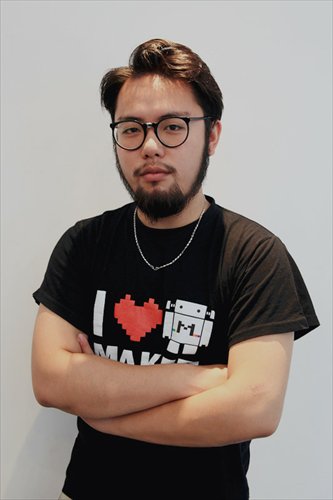The maker movement

Wang Shenglin, co-founder of Beijing Makerspace Photo: Courtesy of Beijing Makerspace
"We are good at making one into 100, but what Chinese people need to consider now is how to make one out of zero," said Wang Shenglin, co-founder of the Beijing Makerspace.
Located on the fourth floor of the International Digital Design Center in Zhongguancun, dubbed China's Silicon Valley, Beijing Makerspace is a community that gathers the China's innovative individuals or "makers."
In this office of about 1,000 square meters, "makers" strive to design and craft devices by using the open-source hardware of electronic products or computers that are available for public use at no charge. Hi-tech tools including 3-D printers are equipped for people to DIY their electronic gadgets, robots and even remote-controlled aircrafts.
The rise of Makerspace, which originated in the US and has swept the globe, is referred to as the "maker movement." Former editor-in-chief of The Economist Chris Anderson described it as a new Industrial Revolution.
Wang leads one of these pioneering groups who sensed this mass fervor for innovation in China. To provide a platform for the "makers" to share their experiences, he launched the Beijing Makerspace in 2011.
Born in 1988, Wang majored in business at Renmin University of China. Having worked in a variety of different roles, from a clothes designer in France and a business teacher in Ukraine, he was even a micro-film maker in Beijing.
The establishing of Beijing Makerspace for Wang was not like starting a normal business. It was more like finding a place where people with a common interest could play together. As a "maker" himself, Wang designed a multi-touch table on which a number of people could play a game on the same touch screen at once.
But "makers" do not only refer to those hi-tech wizards out there. Wang encourages everyone to participate. The Beijing Makerspace regularly holds activities for children to inspire them to design and create.
"I want to establish a platform in which everyone can create," said Wang.
The key breakthrough of the "maker movement" is the popularization of open-source hardware. Just imagine a chef from a Michelin star restaurant sharing all his recipes and cooking utensils so that everyone could learn to cook a dish of delicacy at home.
"Too many scholars and experts are busy researching into the same issue, but they never communicate together on it," said Wang, who believes that this is a total waste of intelligence. "The problem that one expert gets stuck on, might have been solved by another." This is because every company is so anxious to get the patent for its technology, and no one wants to leak any information, according to Wang.
The core idea underlying the open-source technology, is to let those with the ability to innovate stand on the shoulders of giants. Arduino, for instance, is now a popular open-source electronic platform for "makers" in which many interactive programs, including 3-D printers, can be worked on together.
Makerspace provides the space for the "makers" to share their ideas and knowledge, as well as the tools for them to realize their ideas.
"Having a creative idea about something is far from creating it, since craft is involved in the latter," said Wang. Many people may start with a splendid idea, but end up finding it too hard to make it into a reality.
"There is no other country that can perform better in craft and manufacturing than China," said Wang. With an ever-growing market and firm support from the government, China is gaining its advantage in this new Industrial Revolution.
"We need to make more micro films to record how our ordinary 'makers' have turned their ideas into physical inventions," said Wang, "It will inspire more people to join in our movement and make a difference."